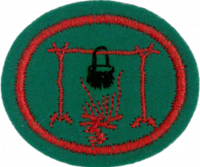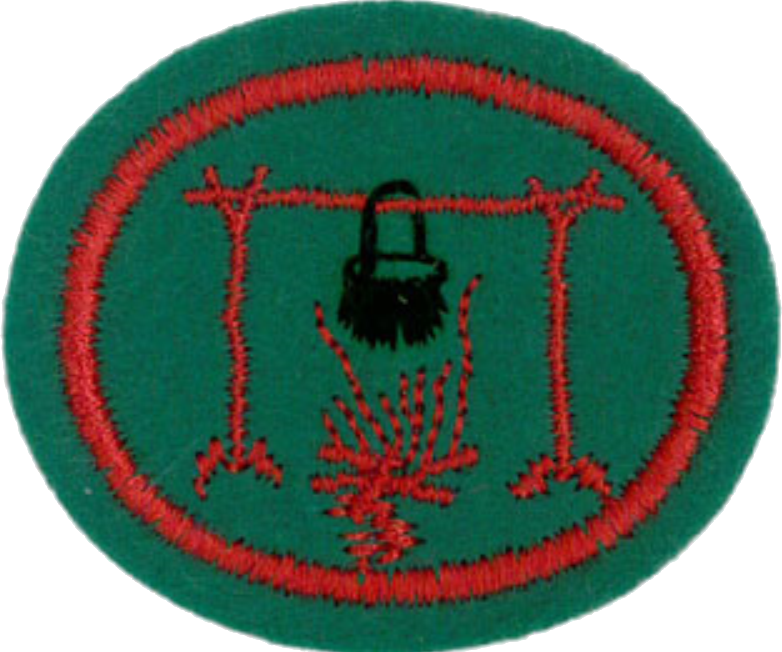Відповіді для Hагорода AM Лагерное ремесло
Уровень сложности
1
Рік
1929
Version
11.11.2025
Орган затвердження
Генеральної Конференції
1
2
Warm Weather Clothing
Keep in mind that the weather can change suddenly. Just because it is warm when you begin your outing does not mean it will be warm the whole time. If there is a chance that the weather will turn cold, take along some cold weather gear as well. Check an almanac to see how cold it can get during the time you are planning to be out.
Here is a list of clothing appropriate for a warm-weather outing.
- Thick socks
- Jeans
- Light Shirt (short sleeve)
- Light Shirt (long sleeve)
- Hat with a wide brim
- Boots
Cold Weather Clothing Remember to dress in layers. This will allow you to control your temperature better. In cold weather, you do not want to sweat, because that will soak your clothing and chill you. If you find yourself working up a sweat, remove a layer of clothing, or open a zipper. Rely on wool rather than on cotton, because wool stays warm even when wet. There is a popular saying among experienced outdoorsmen that "Cotton kills." This is because when cotton gets wet, it steals the body's heat which can lead to hypothermia and death. Your outer layer should be wind-proof, as this greatly increases the warmth of your clothing. Here is a list:
- Thermal Underwear
- Light shirts (polyester or some other synthetic)
- Heavy Shirts
- Wool Sweater
- Wind Breaker
- Fleece Pants (synthetic)
- Nylon Pants (as the outside layer) or snow pants
- Overcoat
- Wool Socks
- Boots
- Warm Hat
Sleepwear For comfortable sleeping and for modesty on overnight trips, bring pajamas or a sweat suit. In many places where it is warm during the day it gets cold at night, so be prepared.
3
Fire Safety
- Locate the fire in a safe place. It should be clear for 10 feet (3 meters) all around.
- Do not light a fire beneath overhanging branches or tents, shelters etc.
- Do not use accelerants, such as lighter fluid, gasoline, kerosene, etc. Learn to light a fire without these.
- Put the fire out completely before leaving it. If it's too hot to put your hands in the ashes, it's not sufficiently out. Douse it down with water, turn the coals with a shovel, and be sure to extinguish every coal and ember.
- Do not build a fire on top of flammable material such as grass or leaves.
- Cut away the sod (keep it moist so it stays alive, and replace it before your leave), and clear away the duff and litter.
- Keep fire extinguishing supplies handy and near the fire. A bucket of water or sand, or a fire extinguisher are recommended.
- Do not remove burning sticks from a fire.
- Watch for embers that escape the fire pit and extinguish them immediately.
- Wear proper footwear around a fire.
- Be aware that paper, cardboard, and leaves create floating embers that rise out of the fire pit and may land dozens of yards away.
- Do not light a fire when conditions are adverse (high winds, or drought conditions) or when fires are prohibited by law.
Axe Safety
- Before chopping any wood, take a gentle practice swing to check that the axe will not catch on anything (such as an overhead branch).
- Consider what will happen if you miss whatever you are chopping at - will you accidentally hit a finger? A foot? A bystander? Leave plenty of margin for error.
- Make sure the axe head is firmly attached to the axe handle. If it is loose, you may tighten it by wetting the handle, by driving a hardwood wedge into the handle through the eye of the blade, or by rapping the axe handle vertically on a hard surface.
- Keep bystanders away by one arms length plus two axe-lengths.
- When handing someone an axe, present the handle to them rather than the blade.
- Walk with the blade facing away from you.
- Sheathe the axe when it is not in use.
- Always maintain firm footing when using or carrying an axe.
- Stop when you are tired and rest. Tired people are more prone to accidents and mistakes.
Poisonous Plants
Poison ivy, poison oak, and poison sumac all cause a rash when oils from the plant come into contact with the skin. The contact does not have to be direct - it can be transferred from the plant to another item, and then to the skin. Tools, pets, and clothing can all transfer the oil from the plant to the skin. The best defense against this rash is to be able to recognize these plants, stay alert, and avoid contact. If you do come into contact with any of them, the first thing you should do is immediately wash the affected area with soap and water. This will, in many cases, prevent the rash from developing. If contact went undetected and a rash does develop, apply Calamine lotion or a cortizone cream to the affected area. If the rash develops on the face or genitals, seek medical attention.
4
- Keep your blades sharp. A dull knife is difficult to push through wood, requiring additional force. When the wood finally gives, the blade keeps going.
- Always push the blade away from you, and constantly consider where the blade will go.
- Keep your fingers clear of the blade at all times.
- When splitting wood with a knife, do not hammer on the back of the blade. This weakens the attachment to the handle and deforms the blade.
- Close a pocket knife when it's not in use or when you are carrying it.
- Keep all blades away from heat. Heat will remove the temper, softening the blade. A soft blade will not hold an edge, making it nearly impossible to keep it sharp.
5
Personal Items
In addition to the items of clothing listed in requirement 2, you will also need several items of personal gear.
6
Use the USDA's Food Pyramid for selecting foods. The chart here shows how much of each type of food Pathfinder-aged girls and boys should eat over the course of an entire day:
7
7a
7b
7c
7d
7e
8
The best advice about being lost, is - DON'T! And the best way to keep from getting lost is to stay on the path.
If you suddenly realize that you do not know where you are, then here are some things to do:
- Don't panic. You can't think clearly when you panic, so take a deep breath and relax.
- Pray. You may not know where you are, but God does, so talk to Him.
- Look around - maybe you'll recognize something that can guide you back to civilization (such as a blaze marking on a tree or rock, which indicates where the trail is).
- Listen for the sounds of other campers, traffic, waterfalls, rivers or anything that might help you find your way back. If you cannot see anything that you recognize and shows you how to easily get back or get help, STAY PUT.
- If you have a map and compass, try to locate your position by looking for hills, valleys or streams.
- You can try to relocate the trail, but you do not want to get any further away from your last known location. Mark your location with something - a backpack, hat, or a large rock - but make sure it's something unmistakable. Then venture 10 paces out, and circle your marker, all the while looking about to see if you recognize the trail or a landmark, and always keeping your marker in view. If you do not see anything you recognize, widen the circle by another 10 paces and repeat. Continue circling your marker at ever wider intervals, but stop when continuing would cause you to lose sight of the marker.
- If you cannot identify your location, STAY WHERE YOU ARE. If you are near a trail, stay there. It is a lot easier for someone to find you if you stay put.
- If you have a whistle, blow on it. If you don't have a whistle, yell loudly. Someone in your party might hear you. Repeat this every 15 minutes or so and be sure to listen after each sounding. Three of anything is universally recognized as a call for help, so three whistle blasts, or three shouts.
- Do not climb a tree or steep hillside. It may seem like a good idea, but it is not worth the risk of falling and getting hurt. The chances of you seeing anything helpful are low.
- If it's an hour or less until sunset, prepare to spend a comfortable evening. Make a shelter and light a fire. Things will look better in the morning, and your fire may attract a rescuer. Remember, stay where you are.
To learn more on this topic, review the Hug-A-Tree education program created by the National Association for Search and Rescue.
9
A three-day campout often starts on Friday evening and ends Sunday at lunchtime. This adds up to six meals, so you will need to divide your campers into no more than three smaller groups. Each camper in your party should be assigned kitchen duty. It is easier to remember which meal a person is responsible if they are assigned the same meal every day - for instance, you might designate a breakfast group, and they will cook all breakfasts. However, if your group is attempting to earn several camping honors at once, you should look at the types of meals each person is required to cook (one-pot, boiling, frying, reflector oven, etc.) and vary the assignments based on that.
10
- I will camp only where camping is allowed.
- I will keep my campsite clean at all times, and I will leave it cleaner than when I found it.
- I will never leave my campfire unattended, and when I leave I will be sure that it is entirely out.
- I will never use my knife or ax to cut, mar or scar live trees.
- I will never pick wild flowers without permission.
- I will never cut trails while hiking.
- I will never pollute a lake or stream.
- I will always respect the privacy of other campers.
- I will always be polite and courteous.
- I will respect all signs, authority, rules and private property.
- I will always conduct myself as a Pathfinder and a Christian and as a child of God.
- I will always leave a campsite knowing that I am welcome to return.
References
- Hug-A-Tree Program. National Association for Search and Rescue. 2020. https://nasar.org/education/hug-a-tree/.




